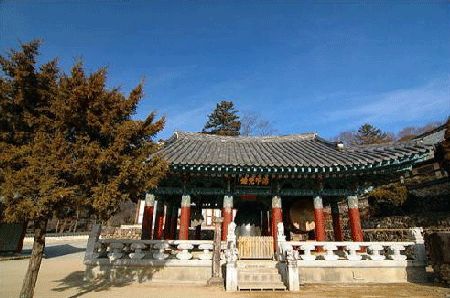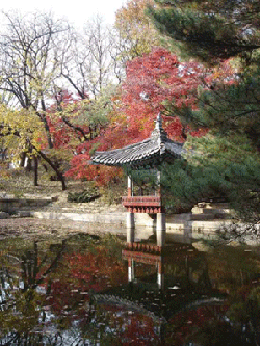
Chogyesa Temple is the only major temple within the old city walls of Seoul. Built in 1910, the temple became the main temple of Korean Buddhism’s Chogye Order in 1936.
In 1954, after the great clean-up movement to rid the country of any vestiges of the Japanese occupation, the temple came to be called Chogyesa. This is the name of the mountain on which the Sixth Patriarch of Chinese Ch’an Buddhism, Huineng (638-713), lived.
Born poor and illiterate, Master Huineng attained enlightenment on hearing the Diamond Sutra being chanted while selling wood. Eventually he was recognized by the fifth patriarch and became his successor.
The Main Hall was built in one year and seven months, beginning in March 1937. It is an impressive wooden structure which is decorated on the outside with paintings of the Buddha’s life and teachings, and has huge, wooden latticework doors.
Inside, the comparatively small Buddha statue is of unknown origin. There is a story told, however, that it came from Togapsa in Cholla-do Province. Behind the statue is a traditional painting. The central figure is Sakyamuni, the Historical Buddha, and on either side of him, from the bottom up, are guardians, Bodhisattvas, and, at the top, some of the Buddha’s disciples. On either side of the glass case containing the Buddha there are cases containing sutras carved on wooden blocks.
The central shrine is flanked by paintings of hundreds of Buddhas. They are symbolic of the many Buddhas in the universe. This temple hall is a major center of Buddhist events. Nearly every night of the year there is some kind of religious activity going on: a lecture, chanting and bowing classes, special ceremonies and celebrations. Behind the Main Hall of Chogyesa is the headquarters of the Chogye Order. In front of the buddhism party Main Hall is a seven-story pagoda containing a relic of the Buddha which was brought to Korea by a Sri Lankan monk in 1914.
In front of the Main Hall, to the left, is the bell pavilion. There hang the drum, the bell, the gong and the fish, instruments used to regulate temple life and call all willing sentient beings to listen to the liberating words of the Buddha which are chanted at every ceremony.
First the drum is rhythmically beaten, calling the animals. Then the large bell calls those who suffer and live in the realms of torment -in the morning it is struck 28 times, in the evening 33 times. And then the cloud-shaped gong calls the beings of the air. The log carved into the shape of a fish calls all that live in the water. At 4 a.m. and at 6 p.m. in winter and 7 p.m. in summer, every day of every year, a monk is in charge of sounding these instruments at Chogyesa – it is a wonderful sight to see.
Behind the Main Hall there is a newly constructed hall, called the Hall of the Virtuous Kings’ and it is dedicated to Amitabha, the Buddha of Universal Light. Beside the principle Buddha, there are Ksitigarbha, the helper of those in trouble and Avalokitesvara, the Bodhisattva of Compassion.
In the Chogyesa compound, there is also a 500-year-old white pine tree supposed to have been brought from China.
There are many Buddhist shops just outside Chogyesa where you can buy books, bells, mokt’aks, statues, and other souvenirs.
Adresse: 45 Gyunji-dong, Seoul, South Korea 110-170
Tél: +82 (0)2 720 1390
Web: www.jogyesa.org





